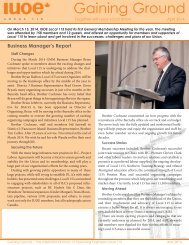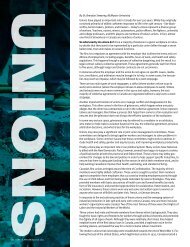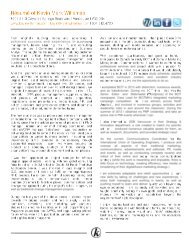OKANAGAN CRUSH PAD
Create successful ePaper yourself
Turn your PDF publications into a flip-book with our unique Google optimized e-Paper software.
This media selection is rewarding in terms of measurement and cost effectiveness. Email marketing is the easiest direct<br />
communication vehicle to measure, and can generate a high return on investment. Open rates and click through rates can be<br />
measured and monitored; however, OCP does not take advantage of these metrics to improve their communication.<br />
Emails, newsletters and blasts are sent whenever they are finished being written (between two and four in the afternoon). This<br />
is not an effective time of day to reach OCP’s primary target audience, as they have already checked their emails that morning.<br />
The fact that the blasts are sent on Wednesdays is effective, considering midweek emails are found to return the best yields<br />
(Comm 100, 2012). Also, subject lines, such as “Wine Wednesday Update”, are not interesting and don’t grab readers attention<br />
when skimming through the vast inbox. Landing pages are effective; they relate to the subject being discussed in the email.<br />
The long-term returns on e-newsletters outweigh the associated costs - each mailing costs between $0.20 to $0.35 to send (in<br />
OCP’s case this could be higher, as they have a smaller customer list), but have the potential to generate repeat purchases and<br />
loyal customers for life. OCP doesn’t take full advantage of their transactional emails to cross-sell, upsell, and effectively<br />
promote or position the brand.<br />
Although OCP communicates their brand personality through the humorous tone of mailings, no consistent messaging is<br />
delivered between channels, relating to the current campaign. The email and e-newsletter’s visual appeal is limited to the nature<br />
of informational transactions and templates provided by Constant Contacts; they are professional and flat. Newsletters contain<br />
generic stock photos, employee photos and a variety of colors and images that do not represent the crisp, modern, quirky brand<br />
character of OCP - an aspect OCP should be emphasizing, and capitalizing on.<br />
Direct Mail<br />
When clients receive their wine orders, they receive a handwritten thank you card or email, when appropriate (see example in<br />
Appendix D-2). Letters are written from Christine and Steve, and use a playful, conversational, humorous tone; this expresses<br />
and establishes OCP’s personality. A card sent to media during their launch last year, is included in Appendix D-3, as an<br />
example of OCP’s writing style. They are able to utilize this touch point because they are a small-scale company and can<br />
manage their clients on a one-to-one marketing level. OCP may also send printed newsletters (see examples in Appendix D-4),<br />
invoices and event invitations.<br />
This follow-up piece is appropriate for OCP to take advantage of, as they are focused on building relationships and lifetime<br />
customers (clients). The follow up notes/cards/letters reinforce the personable, friendly brand personality of OCP and is suitable<br />
for the target market and industry as wine is social and often gifted; thank-you cards are just common courtesy. The brand<br />
benefits of the products are indirectly shown as one of the images includes an egg-shaped fermentation tank and Okanagan<br />
facilities. It takes advantage of this touch point and closed loop communication, which reinforces a positive brand image.<br />
As trade purchases are large in nature, OCP can afford this highly personalized method of communication because the<br />
relationships and repeat orders generated from customers heavily exceed mail costs. Also, ride-along mailers (thank you cards)<br />
require no additional shipping costs as they are sent with pre-purchase orders. This extra effort creates a stronger relationship<br />
with the customer; a lifetime value that exceeds print and human labour costs.<br />
Social Media<br />
OCP uses social media to communicate with their secondary audience. OCP actively uses a Twitter account, Facebook page,<br />
and YouTube channel. They also manage Twitter and Facebook accounts for the Haywire and Bartier Scholefield brands.<br />
Twitter<br />
OCP actively engages with the larger community by posting and tweeting content that reinforces their brand personality (see<br />
Appendix D-6). They utilize this tool by tweeting constantly (about five to ten times per day) and creating discussions about<br />
their wines, media mentions, and events they take part in (OKCrushPad, 2012). This has allowed them to build a substantial<br />
follower base.<br />
LOGICAL ART Page | 12


















